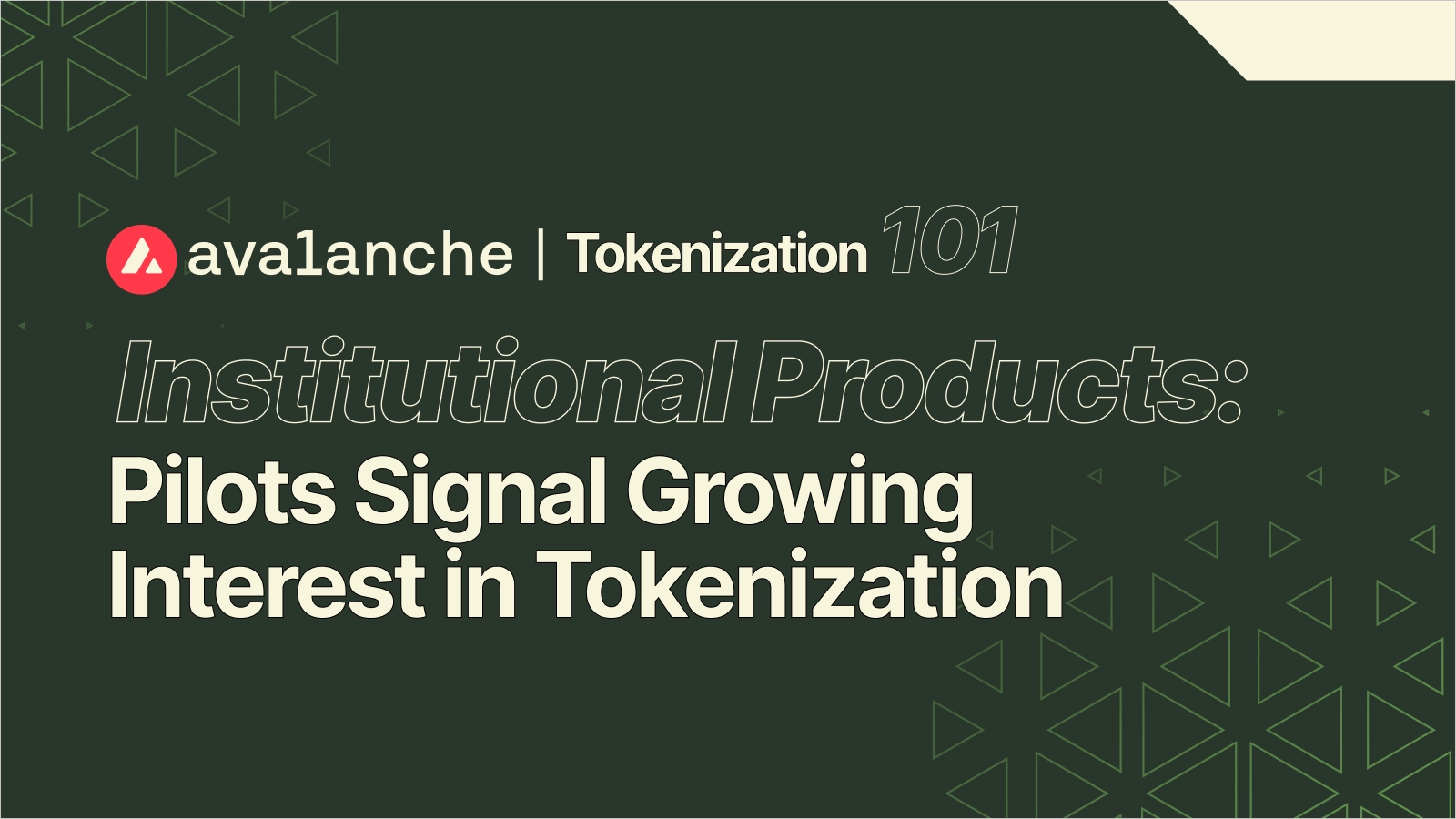Institutional Products, Pilots Signal Growing Interest in Tokenization
Institutional Products, Pilots Signal Growing Interest in Tokenization
Jan 30, 2024 / By Avalanche / 5 Minute Read

The latest tokenization 101 explores how financial institutions have furthered OnFi progress regardless of market conditions
Heading into 2023, the macro backdrop for the crypto industry was bleak. And yet, from then through now, major traditional finance (TradFi) firms have continued executing their blockchain and digital asset strategies. This time felt different than past cycles. How?
Enterprise-grade infrastructure became more prevalent
Wall Street executives finally bought into the tech, touting tokenization as the next generation for markets
Increasing rates globally combined with diminished DeFi yields and growing adoption of non-yield-bearing stablecoins put a focus on bringing “real-world assets” or “real yield” onchain
The continued maturation of DeFi showed how tokenized assets could have novel utility
Ultimately, recent institutional efforts have spoken to a collective endeavor in growing onchain finance (OnFi), or using blockchain, tokenization, and smart contract logic to upgrade legacy infrastructure, institutional workflows, and global finance.
Thematically, institutional OnFi efforts fell into three general categories: tokenization of cash and cash equivalents, tokenization of alternative assets, and native onchain asset issuance. Here, we explore how institutions have been cultivating each – and explain what this progress means for finance more broadly.
Tokenization of Cash & Cash Equivalents
Overall, tokenized cash initiatives focused on CBDCs (e.g., HKMA’s Project mBridge, BIS’ Project Mariana), tokenized deposits (e.g., from ANZ and Citi), and enterprise stablecoins (e.g., PayPal’s PYUSD) for a range of use cases, including cross-border transactions and currency conversions, remittances, peer-to-peer transfers, and tokenized asset payments.
Meanwhile, both crypto-native teams (like Backed, Ondo, and Maple) and TradFi incumbents (like Franklin Templeton, WisdomTree, and Arbdn) propagated tokenized US money market funds and Treasury bills as a means of reserve diversification, yield generation, collateral utility, and even B2B payments.
Tokenization of Alternative Assets
Tokenized alternatives, or alts, have been a focus for two reasons. First, alts have been a massively growing asset class for years and are generally the least standardized and most operationally intensive to administer, and therefore stand to benefit most from this technology. Second, at the same time, the growing affluent and accredited investor markets in the US and abroad are underallocated to alts.
In 2023, several institutions saw opportunity and led tokenized alt endeavors.
Global investment manager Hamilton Lane leveraged Securitize to offer expanded private equity and credit opportunities through tokenized feeder funds. Apollo Global and J.P. Morgan debuted a blockchain-based pilot platform under the Monetary Authority of Singapore’s Project Guardian, leveraging a variety of protocols, including an Avalanche Evergreen Subnet to demonstrate the possibility of including tokenized alts alongside liquid assets in discretionary client portfolios en masse, a possible $400B revenue opportunity for alternative fund managers and distributors. Also under Project Guardian, UK-based asset manager Schroders, and global funds network Calastone, explored the capabilities of tokenized investment vehicles to improve client portfolio personalization, allocation, and operational processing.
Native Onchain Asset Issuance
Rather than tokens representing digital twins of offchain asset or fund ownership, assets issued natively on a blockchain introduce the possibility of recognized legal ownership and other rights, benefits, and obligations in the token itself. Bringing asset issuance onchain has the potential to automate historically manual and siloed components of the process, including the coordination or removal of certain third-party intermediaries and service providers.
A recent HKMA report suggests that tokenized bond issuance benefits “from reductions in underwriting fees by an average of 0.22 percentage point (ppt) of the bond’s par value and in borrowing costs by an average of 0.78 ppt compared to similar conventional bonds issued by the same issuer.” To that end, realizing a lower cost of capital and administrative fees becomes a compelling value proposition for companies considering blockchain-native issuance.
2023 was punctuated by notable institutional examples. The European Investment Bank leveraged Goldman Sach’s DAP to issue a 100M EUR, two-year digital bond, and HSBC’s Orion to issue a 50M British Pound Sterling (GBP), three-year floating-rate note. Germany-based technology company Siemens issued a 60M EUR, one-year bond. The latter was particularly notable in that it was sold directly to investors. Finally, but not exhaustively, UBS, SBI, and DBS completed the first cross-border repo with a natively issued digital bond.
So Why Does this Matter – and Where Is Tokenization Going?
The industry is moving forward. And while ten years, five years, or even one year seem like a lifetime among crypto-native communities, rearchitecting legacy infrastructure and institutional workflows will take time. Consider that it took 25+ years for U.S.-listed ETFs to hit $4 trillion in AUM and global bond ETF AUM to hit $1 trillion.
In 2024 and beyond, pay attention to financial institutions taking a business-first approach to their blockchain efforts, and to those solving real pain points or building new blockchain-enabled products and services. These are the teams that tend to be integrated with and have buy-in from their relevant in-business stakeholders and are focused on bringing tangible utility and value to their clients and financial services at large. Ultimately, they have the positioning and vision to improve legacy infrastructure and finance for all.




